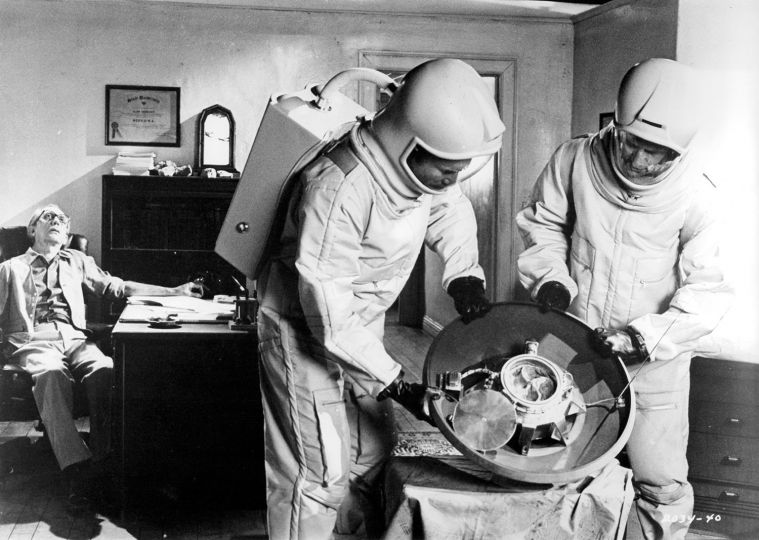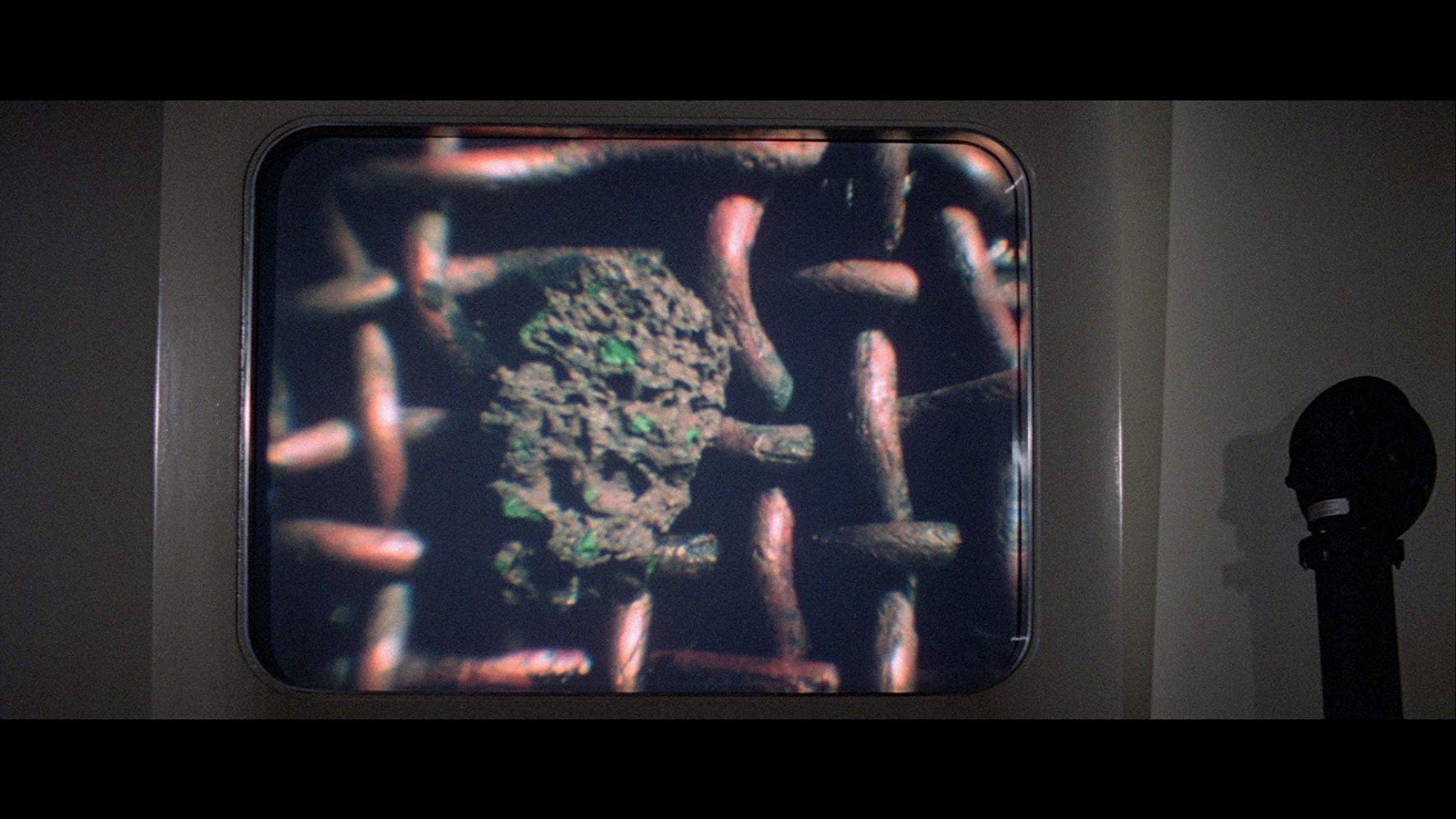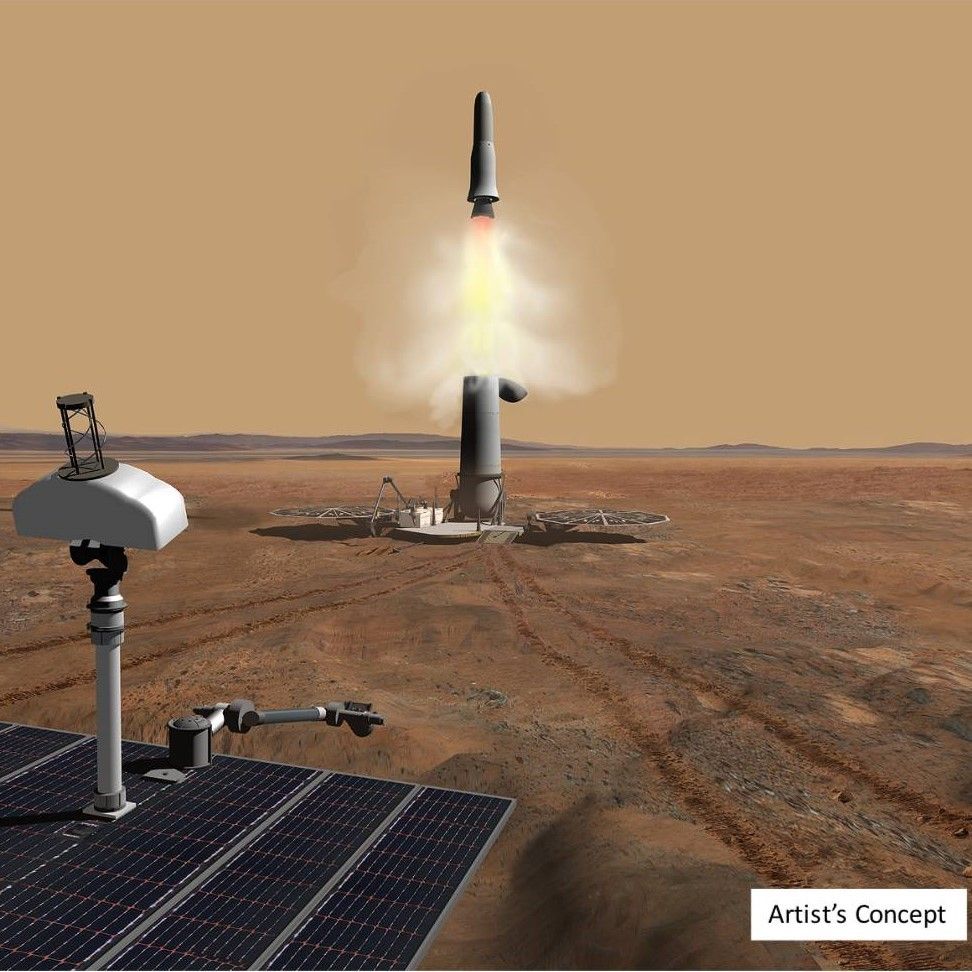
Could Mars samples brought to Earth pose a threat to our planet? What the coronavirus (and 'Andromeda Strain') can teach us.
The coronavirus pandemic reinforces that it's best to be prepared.

NASA and the European Space Agency plan to haul pristine Mars samples to Earth in the near future, perhaps in the 2030s.
Receiving pieces of the Red Planet in this way is deemed to pose a low risk to ecological and public safety — but that risk is not zero.
The Mars samples, which will be collected and cached by NASA's Perseverance rover, could end up being biological "hot property." And the material might spark heated debate and public anxiety about creepy-crawlies from Mars chomping away at Earth's biosphere.
Related: The search for life on Mars (a photo timeline)
Hauling back the goods from the Red Planet resonates in some ways as a replay of Michael Crichton's 1969 novel "The Andromeda Strain," which dramatized the idea of alien organisms infecting Earth.
In the book, which was made into a film in 1971, alien germs are brought to Earth by a "Project Scoop" satellite. An elite team of secretive first responders, clad in protective hazmat suits, studies and battles the bug within a hush-hush, high-tech underground facility named Wildfire.
Will this scenario forever remain science fiction, or could it actually happen in real life? And does the ongoing coronavirus pandemic hold any clues about how to handle samples brought to Earth from Mars, a place that could potentially host extraterrestrial microbes?
Get the Space.com Newsletter
Breaking space news, the latest updates on rocket launches, skywatching events and more!
Stringent containment

The public certainly should pay more attention to plans for Mars Sample Return, said Cassie Conley, a former NASA Planetary Protection Officer.
"Since the beginning of space exploration, planetary protection has mandated that samples from Mars should be considered 'Restricted Earth Return,' Conley told Space.com. "This requires the most stringent containment to protect both the samples and the Earth."
However, in 2019, NASA's Planetary Protection Independent Review Board recommended lowering the planetary protection category for much of Mars' surface to Category II, which would eliminate any requirement for oversight or containment of samples returned from parts of Mars, Conley said.
"We really don't understand Earth biology very well and certainly don't know that much about Mars," Conley said. "So, it's premature to conclude there are no Martian biohazards."
Conley said that "the current pandemic demonstrates, tragically well, how overconfidence and short-term perspectives can cause catastrophic harm to people all over the Earth."
Related: The boldest Mars missions in history

Molecular locks and keys
"It seems to me that public interest in Mars Sample Return safety issues would likely be sharpened by experiences of the COVID-19 pandemic," said J. Andy Spry, a senior scientist at the SETI (Search for Extraterrestrial Intelligence) Institute in California and a NASA planetary protection consultant.
This would hopefully occur "in the same way that the SARS epidemic sharpened the responses of many Asian countries to the COVID-19 hazard," Spry said. "That is, by allowing decision-makers to develop appropriate and timely responses to a microbial pathogen threat."
That said, Spry added, such pathogens usually develop by coexisting with life on Earth, with highly specialized outbreak adaptations as part of an ongoing host-pathogen interaction.
"We can think of pathogenicity as molecular locks and keys which are virtually impossible to develop without repeated contact," Spry said. "Thus, it is extremely unlikely for a biological entity evolving and adapting in an extraterrestrial environment to be able to take advantage of lifeforms on Earth."

Containment facility
While major spacefaring nations share a common perspective on containment of Martian material returned to Earth by a spacecraft, Spry also underscored the international Committee on Space Research (COSPAR) policy language that "no uncontained hardware that contacted Mars, directly or indirectly, shall be returned to Earth." However, implementation details — including those for a containment facility — have yet to be fully worked out, he said.
"This is only because the details of the current Mars sample return mission architecture are still being studied and refined by NASA and the European Space Agency right now," Spry told Space.com. "In the latest scheduling, we are still some 15 years from samples actually being returned to the Earth-moon system, which is still timely in terms of getting containment facility work done."
First things first
Astrobiologist Dirk Schulze-Makuch at Washington State University has been a longtime advocate for having an on-the-spot life-detection mission on Mars first, before attempting sample return.
"We do have the technology to do so. That way we would also have a better idea what we might bring back," he told Space.com. (Perseverance, which will launch this summer, will hunt for signs of Mars life on the Red Planet's surface. But the rover will look for evidence of ancient, not extant, organisms.)
Schulze-Makuch said that a retrieval facility would have to have a high biosafety level, just in case. The chance that any life from Mars would be in any way harmful to us or Earth's biosphere at large is extremely low, he said. He thinks that chance is lower than 1%, but it cannot be totally excluded.
"So, I think the public and planetary protection guidelines would warrant a high biosafety level retrieval facility (3 or, better, 4), which, of course, has a very high price tag as well," Schulze-Makuch said. "And since samples can only be brought back once such a facility is in operation, it will also delay the schedule until we can bring samples back. And if so, we should bring rather 'fresh' samples back, not samples that have been in a box on Mars for years — as is the plan right now."
Heated discussion
One thing to keep in mind, Schulze-Makuch said, is that Earth has already gotten Mars samples — lots of them, in fact, over the eons. Many Mars meteorites have landed on Earth, after all, potentially bringing Martian microbes — if they exist — to our planet.
"Studies have shown that the interior, for example, of Mars rock ALH84001 was never heated above 40 degrees Celsius [104 degrees Fahrenheit], and if there would have been (dormant) microbes in it, they would likely have survived the journey from Mars to Earth," Schulze-Makuch said.
And, of course, there is a heated discussion about whether some Martian meteorites — most notably, ALH84001 — contain evidence of Martian microbial life.
"Either way, the point is that there is also a natural 'mechanism' to bring potentially Martian life to Earth … and if that didn't have detrimental consequences for life in the past, it is unlikely that it will have those in the future," Schulze-Makuch said. "But again, we have to admit that the risk is not zero."
- Mars sample return: scientists debate how to bring Red Planet rocks to Earth
- The 7 biggest mysteries of Mars
- Why we can't depend on robots to find life on Mars
Leonard David is the author of the book "Moon Rush: The New Space Race," published by National Geographic in May 2019. A longtime writer for Space.com, David has been reporting on the space industry for more than five decades. Follow us on Twitter @Spacedotcom or Facebook.
OFFER: Save 45% on 'All About Space' 'How it Works' and 'All About History'!
For a limited time, you can take out a digital subscription to any of our best-selling science magazines for just $2.38 per month, or 45% off the standard price for the first three months.
Join our Space Forums to keep talking space on the latest missions, night sky and more! And if you have a news tip, correction or comment, let us know at: community@space.com.

Leonard David is an award-winning space journalist who has been reporting on space activities for more than 50 years. Currently writing as Space.com's Space Insider Columnist among his other projects, Leonard has authored numerous books on space exploration, Mars missions and more, with his latest being "Moon Rush: The New Space Race" published in 2019 by National Geographic. He also wrote "Mars: Our Future on the Red Planet" released in 2016 by National Geographic. Leonard has served as a correspondent for SpaceNews, Scientific American and Aerospace America for the AIAA. He has received many awards, including the first Ordway Award for Sustained Excellence in Spaceflight History in 2015 at the AAS Wernher von Braun Memorial Symposium. You can find out Leonard's latest project at his website and on Twitter.
-
Catastrophe Yes, of course there is a chance of some malignant strain, but this has to be VERY unlikely.Reply
We are probably in MUCH more danger from a stray asteroid.
I am sure those responsible for bringing back a Mars sample would treat it with great care, probably an antibacterial spray, and safe isolation. Look at all the care taken in the opposite direction.
Now, some will say that alien microbes are immune to our safeguards. Again this is possible but VERY unlikely. Growth of organisms would have to start (and probably still be) very simple and be susceptible to our procedures. But here I am on weak ground - any microbiologists here please to advise? I am thinking in terms of disrupting lipid aggregations in cell walls.
But I am a chemical engineer, not a microbiologist.
Cat :) -
Meteoric Marmot I suggest the author refresh his memory on the Andromeda Strain. The virus was man-made, not extra-terrestrial.Reply -
egribble Reply
As the post says, there has been regular exchange of meteorites and microbes between Earth and Mars for eons. Just about all earth microbes are harmless to us. The micro biomass of this planet is about ten times greater than the total mass of multi cellular life. Single celled anaerobic microbes have been found more than 2 kilometers below the surface, most microbial life is subterranean. Only specific pathogens are a threat. These are organisms that have evolved alongside their multi cellular host for eons. They have evolved to overcome the hosts natural defenses, biological warfare. An ongoing battle between new defense systems and new counter systems. If Mars microbes have evolved in the absence of multi cellular earth life, they simply will not have the capacity to overcome that multi cellular organisms defense mechanisms.Admin said:NASA and the European Space Agency plan to haul pristine Mars samples to Earth in the near future. Should we worry about a possible 'Andromeda Strain' scenario?
Could Mars samples brought to Earth pose a threat to our planet? What the coronavirus (and 'Andromeda Strain') can teach us. : Read more -
Admiral Lagrange Ignoring the theories that covid 19 was man made, It did have a host to evolve and grow (feed). Flesh eating bacteria, virus', and microbes must have it's food or it dies.Reply
If they fear all the conditions exist in the soil to allow this kind of evolution the solution is quite simple:
Send Humans to Mars before bringing Martian dirt to the Earth ! -
dfjchem721 Cat noted: "Yes, of course there is a chance of some malignant strain, but this has to be VERY unlikely."Reply
I would rate it as impossible. Nothing is going to evolve and persist on the surface of Mars with all that radiation, lack of liquid water, etc. It reminds me of our moon guys being stuffed into quarantine chambers so that "lunar bugs" did not wipe us out.
Gotta go with egribble on this one. Any life form evolving elsewhere is not going to be compatible with life on earth. It will likely have all the same stuff, DNA, RNA, proteins, lipids, etc. But structurally it would be highly unlikely for any biological interactions. The closest I can think of is trying to translate languages. And I think intelligent Martians have been ruled out for quite some time....
Never felt good about Spock being half-human either. But that is in the distant future, and sci-fi at that.
And just for the record, viruses are not life forms. You cannot kill it, so it cannot be alive. You can only prevent infections (receptor blockers, protease inhibitors), or inoculate (please work out on this one), or become immune from a viral infection (assuming it does not hyper-mutate like HIV, flu etc.).
If it cannot be killed, it cannot be alive. -
Catastrophe Reply
This is your expertise, mine is surface active agents.dfjchem721 said:Cat noted: "Yes, of course there is a chance of some malignant strain, but this has to be VERY unlikely."
I would rate it as impossible. Nothing is going to evolve and persist on the surface of Mars with all that radiation, lack of liquid water, etc. It reminds me of our moon guys being stuffed into quarantine chambers so that "lunar bugs" did not wipe us out.
Gotta go with egribble on this one. Any life form evolving elsewhere is not going to be compatible with life on earth. It will likely have all the same stuff, DNA, RNA, proteins, lipids, etc. But structurally it would be highly unlikely for any biological interactions. The closest I can think of is trying to translate languages. And I think intelligent Martians have been ruled out for quite some time....
Never felt good about Spock being half-human either. But that is in the distant future, and sci-fi at that.
And just for the record, viruses are not life forms. You cannot kill it, so it cannot be alive. You can only prevent infections (receptor blockers, protease inhibitors), or inoculate (please work out on this one), or become immune from a viral infection (assuming it does not hyper-mutate like HIV, flu etc.).
If it cannot be killed, it cannot be alive.
Would you say that you can disassemble a virus?
By that I mean that you can use soap (long fatty chain ca. C12) with sodium carboxylate for example to break down the cell wall. The cell wall components can be solubilised or emulsified into micelles or emulsion droplets depending on how you want to describe their size. Obviously, as you post, you are not killing it but you are opening out the walls and spilling the contents around. Does that make sense? Would disassemble come close?
Cat :) -
dfjchem721 Cat, it is interesting that you work with surface active agents. I have done a lot of work with them. They are very commonly used in protein research to separate them from other things, etc.Reply
Yes, a virus can be disassembled, and surfactants would be one way to do that. It really depends a lot on the virus and what you want to do with it. Some viruses are pretty simple - nucleic acid bundled up in a protein "coat". Others are much more complex, like the one going around now. That is a retrovirus that uses RNA as its genome, and has a membrane/protein coat (wall).
For all viruses, you have the genome (RNA or DNA) surrounded by a coat.
The simpler viruses could probably be disassembled by urea and some heat. Urea at high concentrations will unwind proteins and make the whole thing fall apart. Some of these could likely be reassembled, and possibly have been. Not sure about that.
A retrovirus with a membrane is much more difficult because the membrane is composed of fatty acid - glycerol conjugates (di- and tri-glycerides). Just like you mentioned, using fatty acids.
You posted: "By that I mean that you can use soap (long fatty chain ca. C12) with sodium carboxylate for example to break down the cell wall." I believe you meant virus "wall".
Soap will certainly mess up the virus, and destroy its activity if you hammer it long enough. That is what the hand washing is all about. Enough surfactant, and a powerful one like a soap will penetrate the membrane and wreck havoc. "Disassembling" (suggesting it could be put back together) a retrovirus would be much more difficult because of this membrane, but it certainly could be done. It would make a much bigger mess of RNA, protein and fats, but it would not be active, that is certain. Reassembly might not be possible, unless great effort was made
One of the most practical virus-inactivating compounds is isopropanol (IPA, around 70%). This solution will allow IPA to penetrate the membrane and wreck havoc on the proteins embedded in it. This include the spike protein the allows docking of the virus with your cell's receptor(s). Inactivation in this case is nearly 100% in a few seconds of contact. -
Catastrophe Not to be too obvious, my working life was virtually all spent on the alternative name for zwitterionic sfa's. I edited (and wrote most of) the Marcel Dekker Surfactant Science Series (the book not the Series) on this type of sfa.Reply
I also had a number of granted patents worldwide on reduction in irritation in sfa products such as shampoos, bath and hand dishwashing products using multiple N groups.
Yes, you could say I worked with sfa's ;)
My apologies for the over simplistic bit above. -
dfjchem721 That is very impressive Cat. I have a few patents on injectable formulations, one using sucrose monolaurate to solulbilize an insoluble active.Reply
The science of surface active agents is impressive, and requires a bit of reverse thinking - often outside the aqueous phase, in an aqueous phase!










